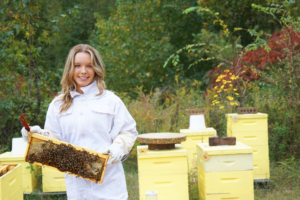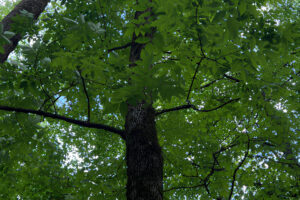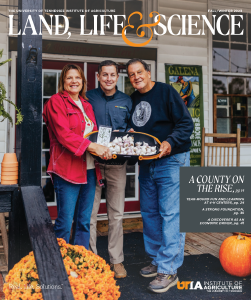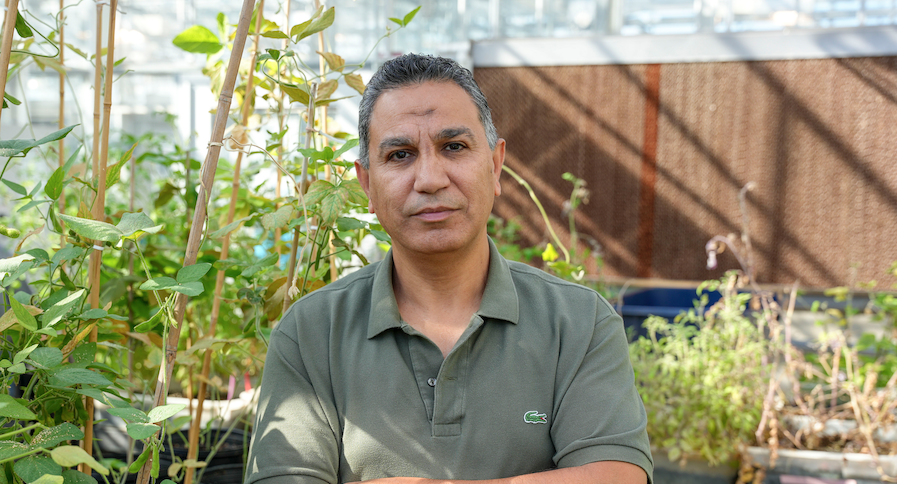
Breakthroughs by a UT AgResearch scientist put a lifelong goal to address world hunger within reach
Growing up in Egypt, Tarek Hewezi would see television news stories about hundreds, if not thousands, of men, women, and children dying because of food crises and starvation. The images stayed with him. The extreme poverty and hunger he saw in areas of Africa became the chief motivation, Hewezi says, that led him to study agriculture and become a plant scientist.
“I wanted to solve problems contributing to famine, and I still do,” Hewezi explains. “I want to always contribute toward improving crop productivity by protecting crop plants from diseases and harsh environments.”
Hewezi is a professor and UT AgResearch plant molecular biologist in the Department of Plant Sciences. He joined UTIA in 2013 and, although he is still relatively early in his career, Hewezi and his lab have achieved two breakthroughs since 2022 whose magnitude seems poised to deliver on his goal to improve world food harvests and food security.
The discoveries are connected to nematodes, the tiny roundworms that parasitically feed upon and injure a host of plants. In August 2022, Hewezi and his lab discovered resistance genes that promise much needed control of the most virulent races, or types, of soybean cyst nematode that harm soybean production in the US and elsewhere in the world.
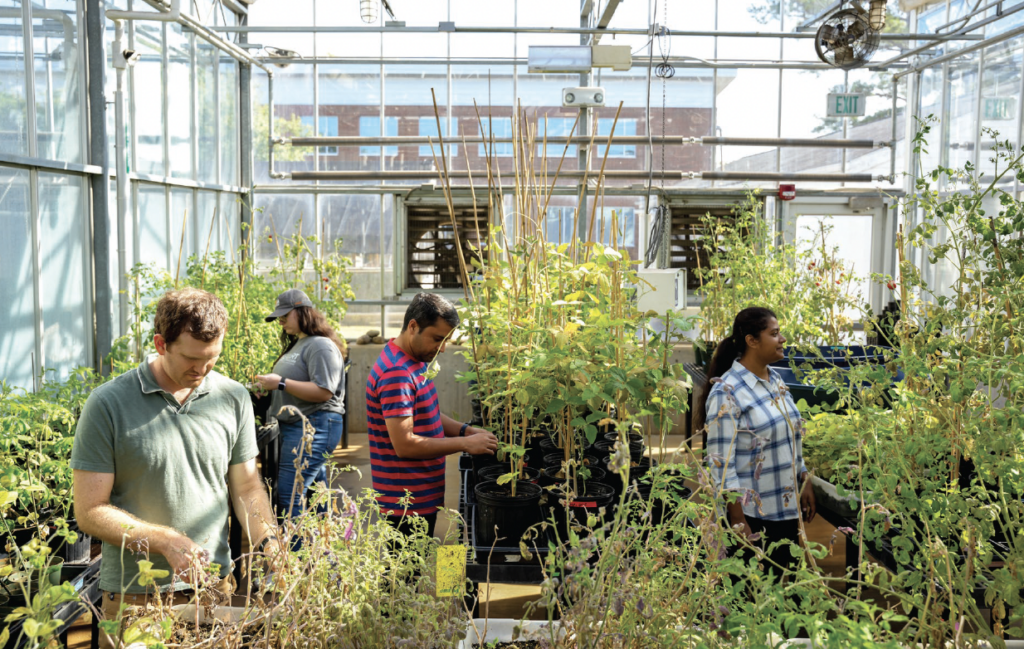
On a different front yet also focused on nematodes, large-scale data screening by members of the Hewezi lab resulted in the discovery of genes that are resistant to the southern root-knot nematode, a pest that harms tomato plants, along with a host of other vegetables, row crops, and even ornamental plants that share genetic traits with tomato—and their number might surprise you.
The discovery of novel plant genes that are resistant to soybean cyst nematode paves the way for the development of soybean cyst nematode-resistant soybean varieties using transgenics, genome editing, or traditional breeding methods. The use of the novel resistance genes, either individually or in combination, is expected to provide a high level of protection against soybean cyst nematode for decades.
The finding will provide resistance to two of the most devastating soybean cyst nematode races: race 3, which is one of the most widely distributed types in the United States, and race 2, the race found in the eastern and southern US. Together, these races cause an estimated annual loss of $1.5 billion domestically alone, and all commercially available soybean varieties are currently susceptible. While many efforts have been made to optimize and improve soybean yield, significant yield losses due to soybean cyst nematode frequently occur in almost all soybean growing regions.
“Tarek Hewezi’s discoveries of resistance to these nematodes derive from research conducted on behalf of Tennessee row crop and vegetable producers. The worldwide benefits the discoveries will bring show the tremendous impacts and reach of the Real. Life. Solutions. our scientists generate.”
– Hongwei Xin, dean, UT AgResearch
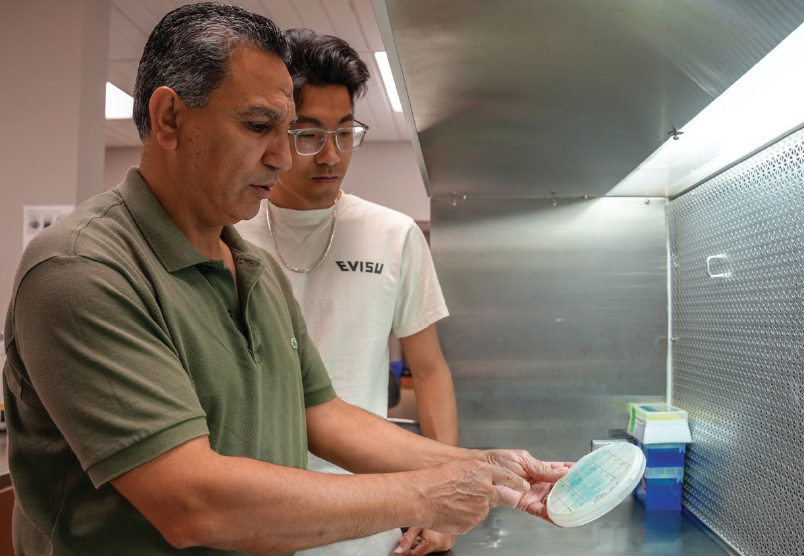
Hewezi and his PhD student Peitong Li examine screening plates for soybean susceptibility genes targeted by nematode disease factors. Photo by Caitlynn Dowland.
The Hewezi lab’s soybean resistance gene discoveries are protected by four patents—one that has been issued, and three that are pending. Hewezi and the UT Research Foundation have signed licenses with GDM Seeds, a major soybean seed company, to bring new cultivars with soybean cyst nematode resistance to the market in the next few years.
The southern root-knot nematode is another of agriculture’s most damaging pests. The nematode infects more than 2,000 plant species and causes worldwide annual yield losses of more than $170 billion across row crop, vegetable, and ornamental plant industries, and no reliable genetic resistance to the pest presently exists.
To identify novel sources of genetic resistance to southern root-knot nematode, the Hewezi lab used nematode disease-causing factors as probes to identify tomato genes that make plants susceptible to damage. In September 2021, his team identified more than a hundred tomato susceptibility genes targeted by nematode disease factors. The team discovered that partial inactivation of some of these genes not only enhances tomato resistance to this devastating parasite, but also increases plant growth and development.
Currently, the Hewezi lab is working toward producing stable genome-edited tomato lines in which these genes are inactivated. This will provide opportunities to integrate nematode resistance into susceptible elite tomato cultivars.
Because of the ability of southern root-knot nematode to infect more than 2,000 plant species, the tomato susceptibility genes are more than likely similar across plant species. Therefore, the lab foresees that the genes can be used to engineer resistance to the damaging soilborne pest in a large number of other cultivated plants, making this UTIA discovery of broad importance to agriculture in the US and worldwide.
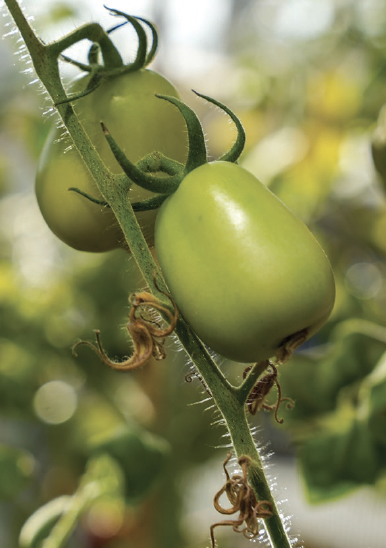
Tomato fruits growing on non-GMO edited line resistant to southern root-knot nematode. Photo by Caitlynn Dowland.
Hewezi is the first to say that he did not anticipate the significance of his research’s findings. He attributes the achievements to the unorthodox research approaches implemented in his lab as well as the hard work of the many talented young scientists who collaborate with him.
“Our decision to study the epigenetics of how these plants respond to the nematodes—of how the plant cells control gene activity without changing the DNA sequence—allowed us for the first time in soybeans to identify genes that are biochemically marked,” Hewezi says. The biochemical label appears to be an important sign to identify genes whose function in disease resistance was lost by artificial selection during soybean domestication and breeding.
Meanwhile, Hewezi says the complexity of tomato interaction with Southern root-knot nematode is frequently masked because most scientific studies focus on single nematode factors instead of looking at them collectively. In their search to identify the most impactful genes, lab members applied large-scale screens in which twelve nematode factors were analyzed simultaneously. The screens of thousands of tomato genes were enormous, and the identification of the resistance genes that came from the effort is equally huge.
To Hewezi, the discovery underscores the enduring importance of basic scientific principles. “I believe there is great value in appreciating the magnitude of basic science when it is applied toward solving major problems in agriculture. The science makes it possible to find solutions that increase plant production and food security on both a national and global scale.”
Helping Others Have Impacts Themselves
Tarek Hewezi is having impacts on increasing food production through mentoring other scientists. “I was fortunate to host two Norman Borlaug fellowship recipients from Malawi and Rwanda,” he says. “One completed his PhD in my lab and then developed a soybean breeding program in Rwanda. The new soybean cultivars he has developed have double the yield of local cultivars.”
It is Real. Life. Solutions. like those that Hewezi says he wants to help others achieve: ones that increase food supply and food security for all.

Explore More on
Features
MORE FROM THIS ISSUE

